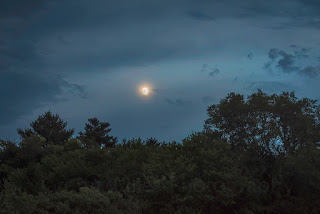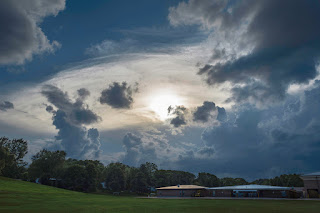No one really saw this one coming.
SPC forecasters posted only a Slight Risk for the state of Iowa on Thursday, July 19, 2018. Models predicted a better chance for hail or wind for the area, with only a 2 percent chance of tornadoes (above).
So surprise was raised when at 3:10 pm CDT
Tornado Watch 285 was posted for central/east central Iowa.
Almost immediately, tornado-warned cells sprang to life and began moving east in central Iowa--lined up from Hardin County in the north to Mahaska County in the south. The
IEM radar images above show reflectivity scans from 2:55 pm, 3:30 pm, 4:45 pm and 5:25 pm. Below,
GOES16 satellite imagery for 4:40 pm, 4:55 pm and 5:17 pm is shown. The Marshalltown storm is circled.
A much more sophisticated visual of the growing storm is this
weatherTAP radar screen image from 3:32 pm. Note the large amount of lightning just east of the Des Moines area, and the "Tail-end Charlie" storm cell. It was soon after this moment that I gathered my photography and communication gear and headed south with the intention of navigating Interstate 380/US Highway 218 south to intercept the "Tail-end Charlie." Driving south through downtown Cedar Rapids I glanced at the tornado-warned radar signatures on radar and began thinking the cell just west of Marshalltown was appearing more and more ominous. A last-minute instinctual decision diverted my objective west toward this storm on US Highway 30.
4:32 pm. I captured this image through the windshield westbound on US Highway 30, about 2 miles east of Highway 21 in western Benton County. It reveals at left the explosive tornadic storm cell as it was approaching Marshalltown, some 35 miles distant. Reflective glare in the image at right shows dashboard items.
4:38 pm. Still westbound on US Highway 30, with the junction of Highway V18 in southeastern Tama County seen in the distance at center-right. I would make a last-second decision to turn here to acquire a relatively safe spotting position away from Marshalltown, where at this moment a powerful tornado was just entering town. The churning clouds in the background of this image are from that storm.
4:40 pm. Arrived at my spotting position, about a half-mile north of US Highway 30 on Highway V18 at 320th Street. Above is a radar screen capture during this time, showing my location (target icon at right), direction and mileage to the tornado (black arrow), and storm movement (white arrows).
4:46 pm. Volatile storm clouds out ahead of the tornado. This image looks northwest from the intersection of Highway V18 and 320th Street. At this moment I received an emergency alert on my iPhone and my weather radio was spewing forth dire warnings such as: "Tornado emergency for Marshalltown. This is a particularly dangerous situation. Expected hazards include an extremely dangerous and potentially deadly tornado."
4:50 pm. Looking north at storm lowering along Highway V18 toward the town of Vining, about 1.3 miles distant.
4:51. Panorama of the storm, stretching from the west sky (left) to the north (right). At least three car occupants stopped to inquire "if the storm was coming here," and a fellow
Spotter Network member from Marshalltown texted me asking if I could see a tornado on the ground from my location--(I could not).
4:51 pm. A single panel from the panorama image above it.
4:53 pm (approximately). A
Go Pro Hero 4 Silver "selfie" of yours truly. This is a frame capture from an 18-minute video. The camera was mounted to the interior of my windshield. This wide-angle view looks northwest and shows much of the tornadic cell's structure.
4:53 pm. Looking northwest. Note the very low cloud base in the distance to the right of the barn. I might have been able to see the Marshalltown tornado if not for the many visual obstructions.
4:56 pm. Three-stitch panorama. The storm cell's updraft edge is becoming very defined at left. At this point the tornado was located about 22 miles away.
5:10 pm. The tornado warning for Marshalltown has been lifted, but the tornado warning has shifted east into southern Tama County (I am located in southeastern Tama County). The image above looks southwest at the storm cell's immense updraft (background), and the approaching inflow cloud-like feature in the foreground.
5:18 pm. Mildly rotating lowering approaching from the southwest. The lowering contains an inflow cloud connector at lower left.
5:22 pm. Looking south. Bowl-shaped lowering is sliding to my southeast (left). Heavier rain was beginning to fall at this moment.
Radarscope video frame capture with tornado warnings corresponding to the time for the image above it, and my location at right (target icon).
5:29 pm. Looking south along Highway V18. Probable funnel.
Radar screen capture at the time of the photograph above it, showing my location (target icon), and the arrow pointing to the area of the probable funnel, about 3 miles to the SSE, just east of the town of Chelsea. In about 15 minutes I headed for home. Surprisingly, despite the volatile nature of weather at this location on this day, nothing really met criteria for me communicating a report to the National Weather Service or to other spotters. No hail fell here, wind was minimal and heavy rain only fell later at different locations on my way home. I am of course mindful of the heavy property destruction wrought by three separate tornadoes to the towns of Bondurant (EF2), Pella (EF3), and nearby Marshalltown (EF3). I am thankful no fatalities occurred from all this unexpected weather!
A map showing the 26 tornadoes reported in Iowa on July 19, 2018.
7:50 pm. A striking but benign end of the day: cumulus towers in the northeast sky, as seen from
Bowman Woods Park in Cedar Rapids. The clouds were located about 14 miles distant, just northwest of Central City, Iowa. Nikon D7200 DSLR camera.
Read more...





























































